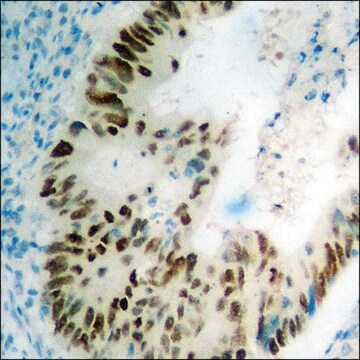P8982
Anti-phospho-p53 (pSer392) antibody produced in rabbit
affinity isolated antibody, buffered aqueous glycerol solution
About This Item
Polecane produkty
pochodzenie biologiczne
rabbit
Poziom jakości
białko sprzężone
unconjugated
forma przeciwciała
affinity isolated antibody
rodzaj przeciwciała
primary antibodies
klon
polyclonal
Postać
buffered aqueous glycerol solution
masa cząsteczkowa
antigen 53 kDa
reaktywność gatunkowa
mouse, human
metody
microarray: suitable
western blot (chemiluminescent): 1:1,000 using p53 fusion proteins with CKII phosphorylation or an extract of hydroxyurea-treated MvILu cells
numer dostępu UniProt
Warunki transportu
wet ice
temp. przechowywania
−20°C
informacje o genach
human ... TP53(7157)
mouse ... Trp53(22059)
Opis ogólny
Specyficzność
Immunogen
Działania biochem./fizjol.
Postać fizyczna
Uwaga dotycząca przygotowania
Oświadczenie o zrzeczeniu się odpowiedzialności
Nie możesz znaleźć właściwego produktu?
Wypróbuj nasz Narzędzie selektora produktów.
Kod klasy składowania
10 - Combustible liquids
Klasa zagrożenia wodnego (WGK)
WGK 2
Temperatura zapłonu (°F)
Not applicable
Temperatura zapłonu (°C)
Not applicable
Certyfikaty analizy (CoA)
Poszukaj Certyfikaty analizy (CoA), wpisując numer partii/serii produktów. Numery serii i partii można znaleźć na etykiecie produktu po słowach „seria” lub „partia”.
Masz już ten produkt?
Dokumenty związane z niedawno zakupionymi produktami zostały zamieszczone w Bibliotece dokumentów.
Produkty
p53 regulates gene expression, cell cycle control and functions as a tumor suppressor. Inactivation of p53 is closely tied to cancer development.
p53 reguluje ekspresję genów, kontrolę cyklu komórkowego i działa jako supresor nowotworów. Inaktywacja p53 jest ściśle związana z rozwojem raka.
Nasz zespół naukowców ma doświadczenie we wszystkich obszarach badań, w tym w naukach przyrodniczych, materiałoznawstwie, syntezie chemicznej, chromatografii, analityce i wielu innych dziedzinach.
Skontaktuj się z zespołem ds. pomocy technicznej




